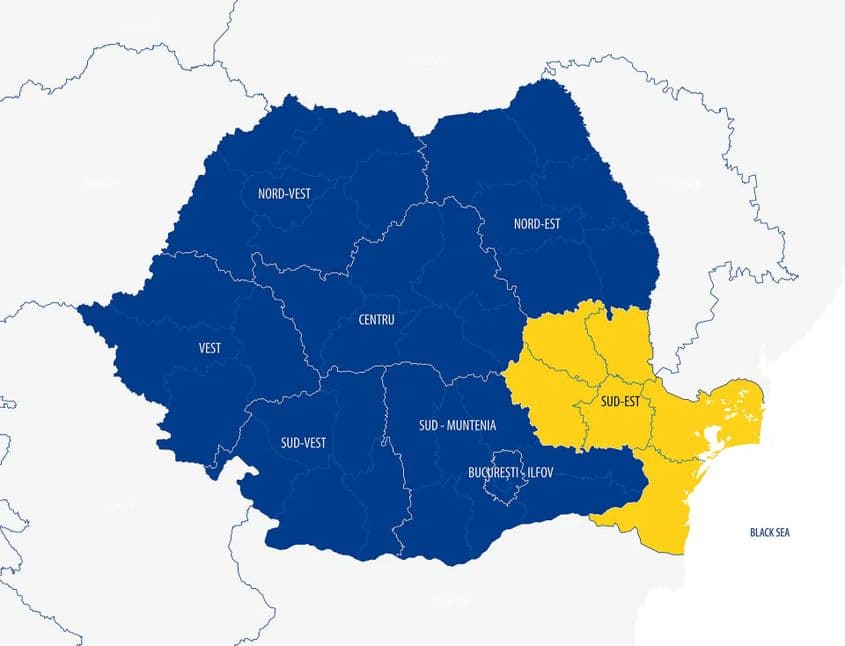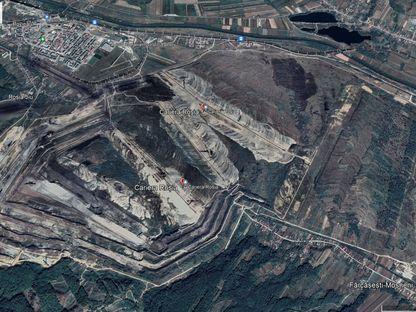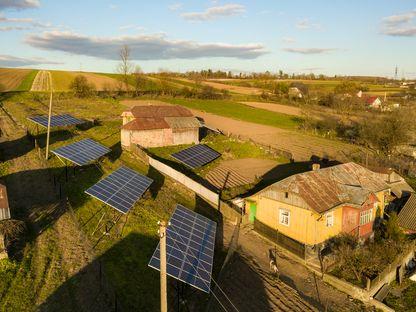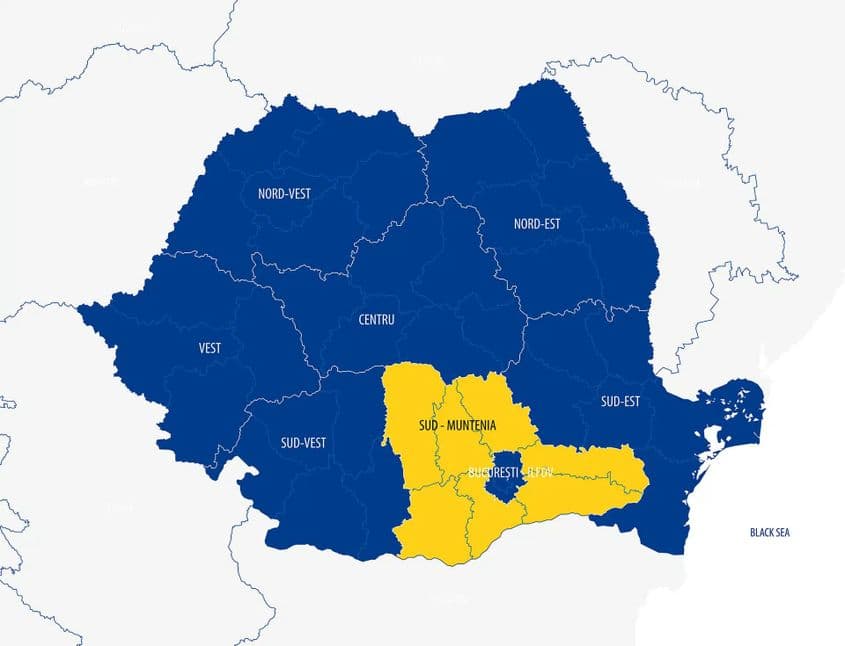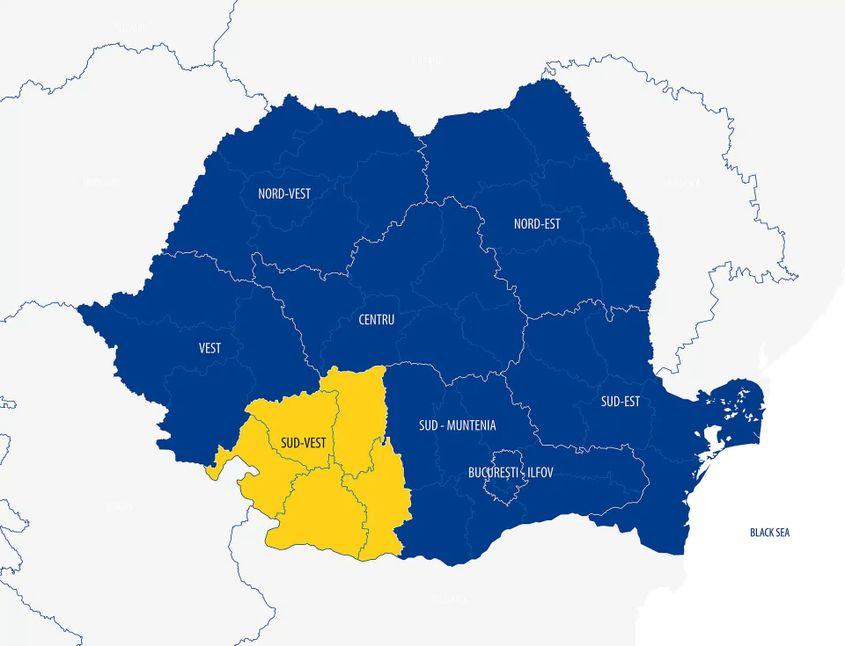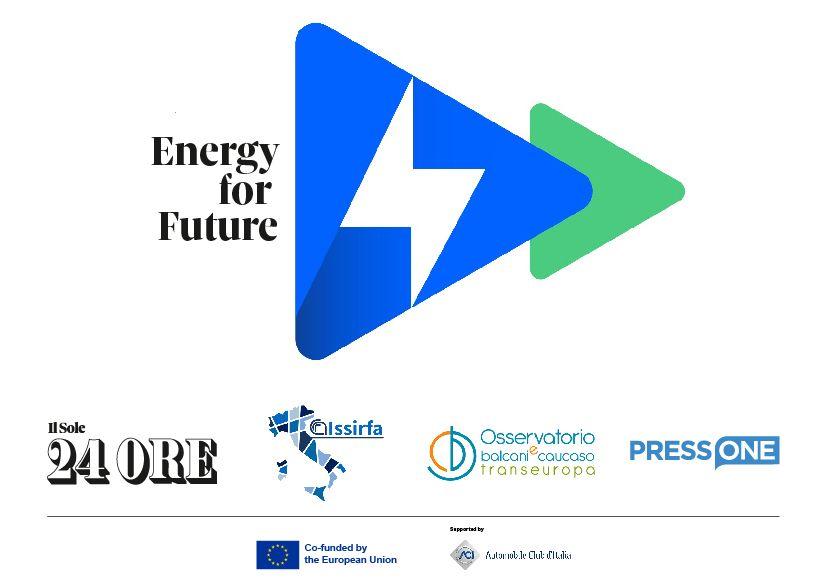Giurgiu, city center. Photo: ID 193495920 | Giurgiu © Unquintu | Dreamstime.com
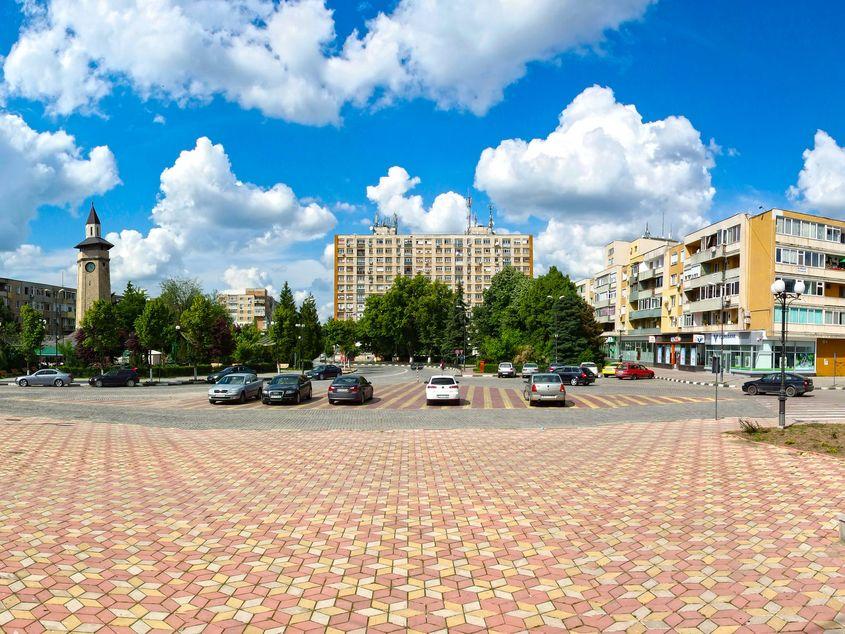
Giurgiu, city center. Photo: ID 193495920 | Giurgiu © Unquintu | Dreamstime.com
25/09/2024
The Map of Contrasts (II). What Life Is Like in Southern Romania and What the Future Holds for Counties Like Călărași, Giurgiu, and Teleorman
PressOne continues its series dedicated to Regional Programs, which, for the first time since Romania has benefited from cohesion funds, are managed by regional agencies rather than a ministry or other central authority.
Thus, each region in Romania now has its own development program, and European investments are expected to help reduce disparities between and within regions.
While the first part highlighted the differences between the West and East of Romania, the second article in the series focuses on Southern Romania, covering the South-East, South Muntenia, and South-West Oltenia regions and their associated regional programs.
The South-East Regional Program
Total budget allocated: €1.48 billion (over €1.2 billion from European contributions and €250 million from the national budget).
Counties included in the program: Brăila, Buzău, Constanța, Galați, Tulcea, Vrancea.
Budget breakdown by priority investment axes:
- A competitive region through innovation, digitalization, and dynamic enterprises: €363,189,750
- An environmentally friendly region, resilient to risks: €361,659,313
- A low-carbon emission region: €200,377,804
- An accessible region: €236,038,346
- An educated region: €86,998,538
- An attractive and inclusive region: €177,046,852
- Technical assistance: €62,760,456
The South-East region is the second largest in Romania, after the North-East. According to the 9th report of the European Commission on cohesion policy, the GDP per capita (adjusted for purchasing power) is at 60.3% of the European average, while the employment rate for those aged 20 to 64 is 63.4% of the European average.
Mulți ne citesc, puțini ne susțin. Fără ajutorul tău, nu putem continua să scriem astfel de articole. Cu doar 5 euro pe lună ne poți ajuta mai mult decât crezi și poți face diferența chiar acum!
According to estimates made in 2022 by the National Commission for Strategy and Prognosis, the GDP per capita in the region could reach €17,343 by 2026 in an optimistic scenario. Constanța is expected to have the highest GDP, while Vrancea will be at the lower end, with a GDP per capita below the regional average.
The discrepancies within the region are also evident in the analysis of the average net salary. If, for 2026, the Forecast Commission estimates that the average net salary in the region could reach 4,573 lei, Vrancea would remain at the bottom of the ranking, with an average net salary of only 4,176 lei. Meanwhile, Constanța is expected to remain at the top of the region in terms of average net salary.
In this context, what are the region's needs?
According to Marin Florian, an expert in European funds, the most pressing need is related to infrastructure: "The South-East region currently has a lot of industry, but no highway." In this context, a project call dedicated to county roads was open for a year, allowing municipalities to apply for funding to rehabilitate and modernize regional road infrastructure. The total budget? Over €178 million.
A region with the sea and the Danube Delta, but no investment in naval transport
Coal Mining Expansion Leads to Deforestation: Over 470 Hectares of Forest Cut Down in Gorj, Romania
Over the past six years, more than 470 hectares of national forest land have been allocated by the government, without compensation, to the Oltenia Energy Complex (CEO) for the expansion or opening of new coal mines.
The not-so-green Romania. The state delays settlements for photovoltaic panels by 2 years
PressOne reviews the main dysfunctions in the production, consumption and distribution of energy from renewable sources, as revealed by discussions with consumers and data provided by official sources at the request of our editorial office.
In the South-East region, the expert continues, there are both the sea and plains, but the projects in the region are too little focused on these areas.
"All industries tied to these production factors should be financed. This doesn't happen because Romania's economic policy hasn't worked that way. We've funded what scored better in evaluations," says Marian Florin.
So far, through the South-East Program, project calls with budgets of millions of euros have been launched to fund projects aimed at reducing carbon emissions in counties and cities, based on sustainable and non-polluting urban mobility plans. Over €140 million is allocated for investments in this area.
Un newsletter pentru cititori curioși și inteligenți.
Sunt curios
For public building energy efficiency projects, there is a budget of €80 million, while residential building energy efficiency projects have a budget of over €31 million.
It is also important to note that 32% of the South-East Region’s surface is occupied by protected areas and the Danube Delta, yet investments in naval infrastructure, for example, have been lacking, says Tana Foarfă, Executive Director of Europuls, an NGO specializing in European affairs, which impacts the workforce.
"The main concern of locals and entrepreneurs is the acute shortage of labor. Many Romanians have migrated either abroad or to other regions of the country offering jobs, and we see this especially reflected in counties like Brăila and Tulcea," adds Tana Foarfă.
Lastly, according to the latest European report on cohesion policy, the South-East Region is also significantly affected by climate change, especially Tulcea County, leading to additional economic costs in the county, the highest in the country, according to European affairs expert Tana Foarfă.
The South Muntenia Regional Program
Map of the counties in the South Muntenia Region. Photo: Ministry of Investments and European Projects
Total budget: €1.5 billion (€1.3 billion from the EU budget, while only €264 million was allocated by the Romanian state to support development projects in the region).
Budget breakdown by priority investment axes:
- A competitive region through innovation, digitalization, and dynamic enterprises: €423,938,789
- An environmentally friendly region (energy efficiency): €365,497,648
- A region with sustainable urban mobility: €215,992,942
- A more accessible region (county roads): €225,147,059
- An educated region: €76,063,527
- An attractive and inclusive region: €203,584,706
The region includes the counties of Argeș, Prahova, Dâmbovița, Teleorman, Giurgiu, Ialomița, and Călărași.
According to the 9th report of the European Commission on cohesion policy, the GDP per capita, adjusted for purchasing power, in the South Muntenia Region was 56.9% of the European average in 2022. When it comes to the employment rate of those aged 20 to 64, the percentage rises to 65.8% of the European average.
The region has three border crossing points with Bulgaria and is traversed by four railway lines that should provide connections to the rest of the country. However, the reality is different. For example, Giurgiu County has been isolated from Bucharest since 2005, when the Grădiștea bridge collapsed. The reconstruction of the bridge and the resumption of railway traffic on the Bucharest-Giurgiu route took almost 20 years.
The South Muntenia region is close to the capital, the most developed of the eight regions. According to experts, this proximity is an influential factor in the region's development. For instance, GDP per capita is above the European average and higher than in the North-East Region, explains Tana Foarfă, Executive Director of Europuls.
However, proximity to the capital also produces less desirable effects, showing that the closeness of some localities to more developed cities does not guarantee that these localities will also prosper, the expert adds.
"Due to its proximity to the capital, the South Muntenia Region is depopulated, with low figures in counties like Teleorman and Giurgiu. This is also reflected in the quality of public administration, the second lowest after the South-East region," says Tana Foarfă.
According to estimates by the National Commission for Strategy and Prognosis, GDP per capita in South Muntenia is expected to reach €16,285 by 2026 in the most optimistic scenarios. In two counties in the region, GDP per capita could grow significantly above the regional average, while in Călărași, for example, it could be more than €5,000 below the average.
Within the region, differences also persist when looking at the estimates made by the Forecast Commission regarding the value of the average net salary. If by 2026 the average net salary across the entire region could reach 4,682 lei, in Teleorman it would barely hit the 4,000 lei mark. Meanwhile, at the opposite end, the average net salary in Prahova could exceed 5,000 lei by 2026.
"If we look at the South Muntenia region, under the 2014-2020 Regional Program (the previous national regional program), most applications submitted and funded in this region came from the counties of Prahova and Argeș, which, historically, even due to their industrial background, had a much greater entrepreneurial appetite. This disadvantages counties like Giurgiu, Teleorman, Dâmbovița, Ialomița, and Călărași," explains Ana-Maria Icătoiu, a European funds expert, in an interview with PressOne.
According to the most recent version of the indicative calendar (March 2023) regarding project calls for the South Muntenia Regional Program, 30 project calls are expected to be launched in the region within the set timeframe.
One of the largest-budgeted project calls is aimed at transport projects that seek to invest in rehabilitating, modernizing, or expanding county roads that connect to the trans-European transport network (TEN-T). The total budget allocated for this project call is nearly €200 million.
Among the project calls with budgets of hundreds of millions of euros is one dedicated to urban mobility. It will fund projects for modernizing public transport networks through the acquisition of electric rolling stock, street widening, the purchase of electric vehicles for school transport, or the development of charging stations for electric cars. The total budget for this project call is over €116 million, targeting both urban and rural municipalities.
More than €45 million is expected to be allocated to projects aimed at improving the energy efficiency of public buildings, while over €11 million is set aside for family residential buildings.
Over €35 million can be granted to urban regeneration projects, which could include the development of bicycle lanes, for example.
The South-West Oltenia Regional Program
Map of the counties in the South-West Oltenia Region. Photo: Ministry of Investments and European Projects
Total budget: €1.2 billion (€997 million from the European budget, while the national budget allocation is €211 million).
The region includes the counties of Dolj, Gorj, Mehedinți, Olt, and Vâlcea.
According to the 9th report of the European Commission on cohesion policy, the GDP per capita (adjusted for purchasing power) in the Oltenia Region in 2022 was 57.3% of the European average, making it the second-highest in the South, immediately after the South-East.
Regarding the employment rate of people aged 20 to 69, the average in Oltenia was 61.8% of the European average in 2022.
"If we look at the employment rate, for example, we see that the South-West Oltenia region has the lowest percentage of employed people in Romania. All of this is directly tied to the level of investment made in key areas: transport, healthcare, and education," explains Tana Foarfă, an expert from Europuls.
According to estimates by the National Commission for Strategy and Prognosis, GDP per capita in the region could reach €16,604 by 2026, with variations within the region. For instance, in 2026, Gorj County could surpass the regional GDP per capita and reach over €21,000, while Olt County would remain at the bottom, significantly below the regional average, with a GDP per capita of only €12,852.
Discrepancies within the Oltenia region are also noticeable in terms of the average net salary. According to the same estimates by the Forecast Commission, the average net salary in the region could reach 4,780 lei by 2026. Meanwhile, in Dolj County, the net salary would be above the regional average, while in Mehedinți and Vâlcea, it would fall significantly below the average.
Of the eight regional programs, the South-West Oltenia Regional Program has one of the smallest total budgets, just €1.2 billion. In contrast, for example, the Bucharest-Ilfov Program, despite being a much more developed region, benefits from a budget of €1.46 billion. The explanation lies in how the government in Bucharest decided to allocate funds for each program, according to experts consulted by PressOne.
"The South-West Oltenia Regional Program has an almost double allocation from the European Union, nearly €1 billion, compared to the Bucharest-Ilfov region, which only receives €586 million. The difference in the total budget is due to the national budget, meaning that the government decided to allocate an additional €880 million for Bucharest-Ilfov and only €211 million for South-West Oltenia," explains Tana Foarfă, Executive Director of Europuls, an NGO specializing in European affairs.
According to the estimated calendar for project call launches, 28 project calls were expected to be released in 2024, with a total value of over €580 million.
More than €130 million has been allocated for transport projects aimed at modernizing and rehabilitating the county road network in the region, including bridges, culverts, road overpasses, and pedestrian footbridges.
Over €51 million has been allocated for investments in educational infrastructure for primary and secondary education, available to public authorities in both rural and urban areas.
Other funding calls are aimed at projects focused on improving green infrastructure, increasing energy efficiency, and promoting sustainable transport.
Rural and urban areas often compete within the same project calls
For all regional programs, many of the project calls target both rural and urban municipalities simultaneously. However, the former lack the resources and administrative capacity that urban areas possess. Rural municipalities often struggle with co-financing, expertise, and experience, explains Ana-Maria Icătoiu, an expert in European funds.
Therefore, according to Icătoiu, administrative reform is essential and vital for the proper development of local communities.
"Reform will mean merging underperforming administrative-territorial units (ATUs), implementing concrete and targeted actions to enhance the administrative capacity of the newly formed ATUs, and strengthening their financial capacity. This would include the ability to cover their co-financing share in European projects," suggests Ana-Maria Icătoiu.
___
This article is published in the framework of the "Energy4Future" project co-funded by the European Union. The European Union is not responsible for the information and opinions expressed in the course of this project and article. The sole responsibility for the content lies with PressOne.
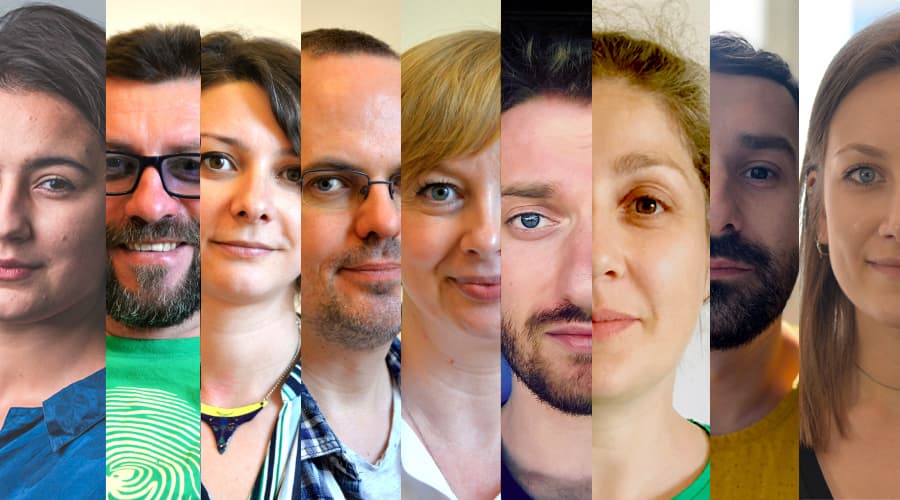
Avem nevoie de ajutorul tău!
Mulți ne citesc, puțini ne susțin. Asta e realitatea. Dar jurnalismul independent și de serviciu public nu se face cu aer, nici cu încurajări, și mai ales nici cu bani de la partide, politicieni sau industriile care creează dependență. Se face, în primul rând, cu bani de la cititori, adică de cei care sunt informați corect, cu mari eforturi, de puținii jurnaliști corecți care au mai rămas în România.
De aceea, este vital pentru noi să fim susținuți de cititorii noștri.
Dacă ne susții cu o sumă mică pe lună sau prin redirecționarea a 3.5% din impozitul tău pe venit, noi vom putea să-ți oferim în continuare jurnalism independent, onest, care merge în profunzime, să ne continuăm lupta contra corupției, plagiatelor, dezinformării, poluării, să facem reportaje imersive despre România reală și să scriem despre oamenii care o transformă în bine. Să dăm zgomotul la o parte și să-ți arătăm ce merită cu adevărat știut din ce se întâmplă în jur.
Ne poți ajuta chiar acum. Orice sumă contează, dar faptul că devii și rămâi abonat PressOne face toată diferența. Poți folosi direct caseta de mai jos sau accesa pagina Susține pentru alte modalități în care ne poți sprijini.
Vrei să ne ajuți? Orice sumă contează.
Share this


